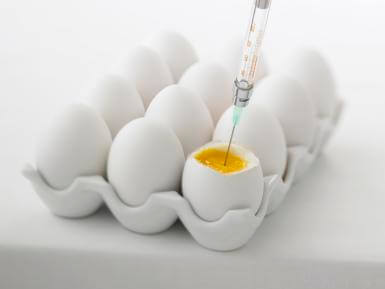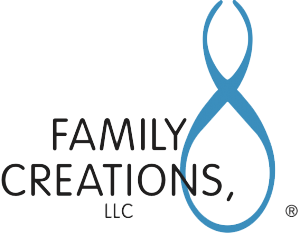
Without stimulating medications, the ovaries make and release only 1 mature egg per menstrual cycle (month). During your egg donation cycle, there are typically 3 medications that you will take over the course of 2-4 weeks. These medications allow your body to produce multiple eggs in one cycle. The medications are self-injectable, and will need to be administered daily. These injections are not intravenous; they are subcutaneous, which means they are inserted just under the skin. The injections are very easy and painless. A nurse coordinator will give you instructions and an overview of how to administer the injections to yourself.
The side effects of the medications are very similar to PMS – you might feel a bit moody, tired, and bloated. However, most donors report not feeling any differently while taking the medications.
The Medications
There are several ovarian stimulation medication protocols that are used to “pump up” the ovaries to make enough follicles and eggs. IVF stimulation protocols in the US generally involve the use of 3 types of drugs:
1. A medication to suppress the LH surge and ovulation until the developing eggs are ready.
There are 2 classes of drug used for this:
- GnRH-agonist (gonadotropin releasing hormone agonist) such as Lupron
- GnRH-antagonist such as Ganirelix or Cetrotide
2. FSH product (follicle stimulating hormone) to stimulate development of multiple eggs
- Gonal-F, Follistim, Bravelle, Menopur
3. HCG (human chorionic gonadotropin) to cause final maturation of the eggs
The ovaries are stimulated with the injectable FSH medications for about 7-12 days until multiple mature size follicles have developed.
Possible side effects of the injectable medications
• Mild bruising and soreness at the injection site
• Mood swings and fatigue
• Nausea and/or vomiting
• Temporary allergic reactions, such as skin reddening and/or itching at the injection site
• Breast tenderness and increased vaginal discharge
• Ovarian hyperstimulation syndrome (OHSS)
“Earlier reports from several decades ago suggested a link between ovarian cancer and the use of fertility medicines. However, more recent and well-done studies are reassuring and do not show this association.”(ASRM, 2015)
Ovarian Hyperstimulation Syndrome
Most symptoms of OHSS are mild and typically subside without any special treatment within a few days after the egg retrieval. Mild symptoms of OHSS include nausea, bloating, and weight gain due to fluid. Severe OHSS is reported in 1-2% of IVF cases. This means essentially that the body has “over-responded” to the FSH and the ovaries become excessively enlarged. Great care is taken by the physician to minimize the chances of this occurrence. In severe cases, OHSS can cause large amounts of fluid to build up in the abdomen (belly) which can lead to blood clots, shortness of breath, abdominal pain, dehydration, and vomiting.
For more information about OHSS, see ASRM fact sheet: Ovarian hyperstimulation syndrome and/or contact a medical professional.
Egg Retrieval Procedure
During the egg retrieval, the doctor will use an ultrasound guided needle that is inserted vaginally. It will go into your ovaries and with gentle suction they will remove the eggs and follicles produced during your cycle. Family Creations ONLY works with highly reputable clinics in the US. This greatly decreases the risk of egg retrieval complications. “Serious complications from IVF medicines and procedures are rare. As with all medical treatments, however, there are some risks. ” (ASRM, 2015)
Most donors do report feeling slightly bloated for a few days after the retrieval. However, the majority of our donors fly back home the day after their retrieval and are able to return to work/school immediately.
Possible Risks of the Retrieval Procedure
• Mild to moderate pelvic and abdominal discomfort. In most cases, the pain can be managed with over-the-counter pain medications and dissipates within a few days.
• Injury to organs near the ovaries, such as the bladder, bowel, or blood vessels. Rarely, bowel or blood vessel injury can require emergency surgery and, occasionally, blood transfusions.
• Pelvic infection (mild to severe). Pelvic infections following egg retrieval or embryo transfer are not common. Severe infection may require hospitalization and/or treatment with intravenous antibiotics.
• Rarely, surgery may be required to remove one or both of the ovaries and tubes and/or uterus. Women who have had pelvic infections or endometriosis involving the ovaries are more likely to get IVF-related infections.
Potential Risks of Anesthesia for the Egg Retrieval Procedure
Lawrece Tsen, associate professor in anesthesia at the Harvard Medical School has indicated that the risks associated with anesthesia are generally very low in the healthy, young women that become egg donors. Falling within the range of a healthy BMI significantly decreases risk associated with anesthesia. (See Family Creations blog on BMI)
Although the risks are considered to be very low in the egg donor population; some of the major morbidities associated with anesthesia are heart attacks, stroke, pulmonary emboli, difficulty breathing and respiratory failure.
Summary
As with any medical procedure, there are potential risks in egg donation. It’s so important to do your own research to make sure that egg donation is the right choice for you. We strongly suggest you speak with a medical professional if you have any questions regarding your personal health and how the egg donation process may affect you. While we have not seen any major medical issues arise with any of our egg donation cases, we at Family Creations encourage all of our donors to be their own best advocates.
We are happy to refer you to a doctor that specializes in Assisted Reproductive Technology to answer any specific questions you have regarding the medical process of egg donation. Give us a call at 818-225-1700.
We look forward to helping you every step of the way!
References
American Society of Reproductive Medicine (ASRM). (2015). In vitro fertilization; what are the risks?. In Society for Assisted Reproductive Technology.
Giudice, L., Santa, E., & Pool, R. (Eds.). (n.d.). Assessing the medical risks of human oocyte donation… In Institute of Medicine and National Research Council Workshop Report (pp. 31-40). Washington, DC: National Academies Press.
Ovarian Stimulation IVF Protocols Medications and Drugs for In Vitro Fertilization (n.d.). Retrieved June 22, 2016, from http://www.advancedfertility.com/ivfstim.htm
